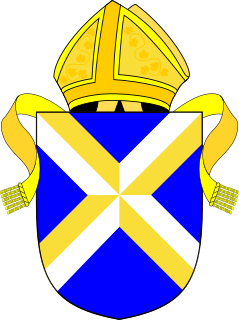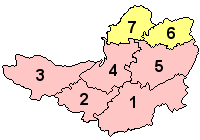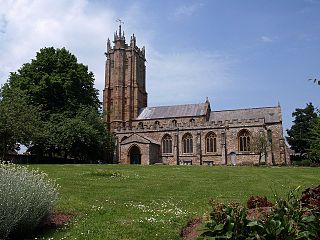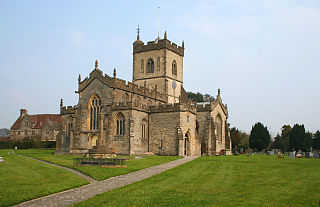| Church of St Mary | |
|---|---|
 | |
| General information | |
| Town or city | Meare |
| Country | England |
| Coordinates | 51°10′18″N2°46′44″W / 51.1718°N 2.7789°W |
| Completed | 1323 |
The Church of St Mary in Meare, Somerset, England, was formerly in the keeping of Glastonbury Abbey, and dates from 1323. It was built for Abbot Adam of Sodbury, and is a Grade I listed building. [1]

Meare is a village and civil parish 3 miles (4.8 km) north west of Glastonbury on the Somerset Levels, in the Mendip district of Somerset, England. The parish includes the village of Westhay.

Somerset is a county in South West England which borders Gloucestershire and Bristol to the north, Wiltshire to the east, Dorset to the south-east and Devon to the south-west. It is bounded to the north and west by the Severn Estuary and the Bristol Channel, its coastline facing southeastern Wales. Its traditional border with Gloucestershire is the River Avon. Somerset's county town is Taunton.

England is a country that is part of the United Kingdom. It shares land borders with Wales to the west and Scotland to the north-northwest. The Irish Sea lies west of England and the Celtic Sea lies to the southwest. England is separated from continental Europe by the North Sea to the east and the English Channel to the south. The country covers five-eighths of the island of Great Britain, which lies in the North Atlantic, and includes over 100 smaller islands, such as the Isles of Scilly and the Isle of Wight.
There is a legend that the church was built on the site of a cell of the monk Saint Beonna (also Benen or Beon), who was later confused with Benignus of Armagh, [2] between the 5th and 9th centuries. His remains were removed to Glastonbury Abbey in 1091. [3] [4]

Saint Benignus of Armagh was the son of Sesenen, an Irish chieftain in the part of Ireland that is now called as County Meath. He was baptised into the Christian faith by St. Patrick, and became his favourite disciple and his coadjutor in the Diocese of Armagh around AD 450. His gentle disposition suggested the name Benen, which was Latinised as Benignus.
The current chancel and tower date from the building's construction in 1323 when it was consecrated by John Droxford, the Bishop of Bath and Wells. Around 1470 the nave was rebuilt by Abbot John Selwood and the work completed by Abbot Richard Beere. The church has a 15th-century stone pulpit, wooden chest from 1705 and candelabra from 1777. The tower holds a peel of six bells. [3]

In church architecture, the chancel is the space around the altar, including the choir and the sanctuary, at the liturgical east end of a traditional Christian church building. It may terminate in an apse. It is generally the area used by the clergy and choir during worship, while the congregation is in the nave. Direct access may be provided by a priest's door, usually on the south side of the church. This is one definition, sometimes called the "strict" one; in practice in churches where the eastern end contains other elements such as an ambulatory and side chapels, these are also often counted as part of the chancel, especially when discussing architecture. In smaller churches, where the altar is backed by the outside east wall and there is no distinct choir, the chancel and sanctuary may be the same area. In churches with a retroquire area behind the altar, this may only be included in the broader definition of chancel.

John Droxford, was a Bishop of Bath and Wells. He was elected 5 February 1309 and consecrated 9 November 1309.

The Bishop of Bath and Wells heads the Church of England Diocese of Bath and Wells in the Province of Canterbury in England.
The parish is part of the benefice of Glastonbury St John the Baptist and St Benedict with Meare, which is part of the Glastonbury deanery. [5]
A benefice or living is a reward received in exchange for services rendered and as a retainer for future services. The Roman Empire used the Latin term beneficium as a benefit to an individual from the Empire for services rendered. Its use was adopted by the Western Church in the Carolingian Era as a benefit bestowed by the crown or church officials. A benefice specifically from a church is called a precaria such as a stipend and one from a monarch or nobleman is usually called a fief. A benefice is distinct from an allod, in that an allod is property owned outright, not bestowed by a higher authority.

Described as "one of the most ambitious parish churches in Somerset", the present Church of St John the Baptist in Glastonbury, Somerset, England, dates from the 15th century and has been designated as a Grade I listed building.
















